Click on this
link
if you cannot read this email.

 |
| |
| |
 |
|
ISPRS e-Bulletin
Issue No 3 - 2017
|
 |
| |
|
 |
|
Quick Links
|
 |
| |
 |
|
Editorial
 |
|
The ISPRS Student Consortium
by Charles Toth
ISPRS 2nd Vice President

ISPRS has more than hundred years of distinguished history, and despite the continuously changing environment, mainly due to the rapid technological developments of the past two decades, the Society is relevant and strong. Obviously, there are many aspects of why ISPRS is successful and prospering. However, one key element is clearly that ISPRS did recognize early on that the future of the Society greatly depends on attracting young people to the geospatial science and engineering profession. It was during the 20th ISPRS Congress held in Istanbul Turkey in 2004 that the ISPRS Student Consortium (SC) was formed. This was a historic moment, as for the first time, students and young professionals all over the world, interested in photogrammetry, remote sensing and geospatial information sciences, could directly connect and be officially represented in the ISPRS organization. The ISPRS SC works under Technical Commission V (formerly TC VI), and primarily collaborates with Working Group V/5.
The beginning of the ISPRS SC followed the usual pattern of lots of excitement mixed with real challenges. Yet the determination of the members as well as support from ISPRS leadership helped the ISPRS SC define its objectives, prepare implementation plans, and create the operational environment quickly in the early years. Since 2007, the ISPRS SC Newsletter has been published quarterly, and is very popular as a platform to keep up with developments, hear about new opportunities, and read about the experiences of other professionals in the geospatial discipline. From early on, the ISPRS SC has become an active contributor to the major ISPRS events, including organizing special sessions and dedicated gatherings for students and young professionals.
The most successful initiative of the ISPRS SC is probably the introduction of the ISPRS SC Summer School program. Clearly, this event became very popular quickly, as it provides a formal and comfortable environment for young people to learn from experts and network with peers. The duration is typically 3-5 days, which is sufficient to acquire a better understanding of a specific geospatial field and gain in-depth practical information of specific areas. The first ISPRS SC Summer Schools were organized in Europe; Istanbul in 2005 and Ljubljana, Slovenia in 2007, but soon it extended to other regions. A major milestone was reached in 2013, when, for the first time, the Summer School was organized on the African continent, Addis Ababa, Ethiopia. Recently, most of the Summer Schools have been organized in Asia, as this region shows the strongest developments in general, and, consequently, the student body is large and interest is strong. In addition, these events are greatly supported by the Asian Association on Remote Sensing (AARS) by continuously providing venue and logistics at their annual ACRS. With the growing interest in Summer Schools, the initial model of one event per year has been changed to multiple events, providing a better geographic distribution to help students attend worldwide. In addition, the cost is kept at a minimum, which allows more students to participate.
What is in the pipeline for ISPRS Student Consortium? The new ISPRS SC website, sc.isprs.org/, has just gone online, and the plan is to further improve the media presence of ISPRS SC community, as this is the de facto communication platform of the current generation. The Newsletter is in the process of being repackaged in this term. Due to changes in structure and organization practice, the Bylaws are updated; the draft is currently under review by Technical Commission V. Finally, the expanding ISPRS SC Summer School program necessitates the development of a standardized application process, which is also in the works.
I wish the ISPRS Student Consortium, under the current leadership of Sheryl Rose Reyes, continued success and growth for the coming years. It is quite remarkable how much progress has been achieved by ISPRS SC recently, and this makes the entire ISPRS community optimistic, not only for the Society’s future, but for the next generation entering the profession, as well as leadership positions at national societies and ISPRS.
↑ Up
|
|
 |
| |
 |
|
The ISPRS Foundation (TIF) News
|
 |
|
TIF Travel Grants - ISPRS Hannover Workshop 2017

The ISPRS Foundation (TIF) has once again been active, supporting the following recipients of travel grants to attend the ISPRS Hannover Workshop in June:
Danang Budi Susetyo, Indonesia; Fredrick Onyango, Kenya; Guoming Guo, China; Luka Jurjević, Croatia, Abdul Rahaman S, India; Sara Mirzaee, Iran; and Dong Lin, and Marc Rußwurm, from Germany.
Read the following Hannover Workshop reports from grant recipients:
a.
Great Experience in Hannover
by Danang Budi Susetyo
b. Report on the ISPRS Hannover Workshop 2017
by Frederick Onyango
c. Report on ISPRS Workshop 2017
by Luka Jurjević
d. Report of the International Joint Workshop of the International Society for Photogrammetry and Remote Sensing (ISPRS) Hannover- Travel Grant
by S. Abdul Rahaman
e. Thankyou to TIF
by Guoming Gao
The ISPRS Foundation depends on individual donations and contributions from ISPRS and ISPRS-sponsored events. Donations to the non-profit TIF may be mailed directly to TIF Finance Officer, Marguerite Madden (Department of Geography, University of Georgia, Athens, Georgia, USA 30602, mmadden@uga.edu for details) or via the TIF PayPal donation link on the TIF website:
http://www.isprs.org/foundation/donations/make.aspx
|
|
 |
| |
 |
|
Society News
|


|
|
Impact Factors reflect the Success of ISPRS Journals

It is my pleasure to inform you of two great achievements within ISPRS publications.
The huge efforts of the ISPRS Editors-in-Chief, the associate editors, many reviewers, and the authors of papers published in the ISPRS Journal of Photogrammetry and Remote Sensing were so successful that the journal has now reached an Impact Factor of 6.387, jumping from 4.18 last year, and is now no. 1 among Remote Sensing journals.
On behalf of Council, please let me to express my thanks to all who have helped achieve this excellent result. The Journal has reached an outstanding position among remote sensing journals.
The Journal is published by Elsevier. More information can be found at:
https://www.journals.elsevier.com/isprs-journal-of-photogrammetry-and-remote-sensing
I would also like to thank the Editor-in-Chief, associate editors, reviewers and authors of the ISPRS Journal of Geo-Information.
The Impact Factor of the Journal has doubled, now reaching 1.502 (2016).
The Journal was founded in 2012 and is published by MDPI. http://www.mdpi.com/journal/ijgi
Lena Halounová
|
|
 |
|
ISPRS Proceedings listed in two Additional Indices

ISPRS is proud to announce that after a lengthy application process the ISPRS Annals of the Photogrammetry, Remote Sensing and Spatial Information Sciences has been accepted for inclusion into SCOPUS. That means the Annals are now available for an even larger audience for search and linkage to the SCOPUS library.
Also, The International Archives of the Photogrammetry, Remote Sensing and Spatial Information Sciences are now included in the online version of E/I, the Compendex. The Compendex, (https://www.elsevier.com/solutions/engineering-village/content/compendex), is an index which is particularly important for the Asian Scientific community.
The Archives are thus listed in the ISI Conference Proceedings Citation Index (CPCI) of the Web of Science, SCOPUS, the E/I Compendex (still pending for the Annals) and the Directory of Open Access Journals (DOAJ).
|
|
 |
|
ISPRS Policy on Pre‐prints in Public Repositories

Due to the increasing popularity of publishing technical reports in public, non-commercial repositories, ISPRS Council has recognised the necessity to address the issue, and developed a policy with respect to the pre‐publication of papers submitted to:
• ISPRS Journal of Photogrammetry and Remote Sensing
• ISPRS International Journal of Geo‐Information
• ISPRS Annals
• ISPRS Archives
Read the policy here ...
|
|

|
|
The U. V. Helava Award – Best Paper Volumes 111-122 (2016) Winner Announced

The winner of the 2016 U. V. Helava Best Paper Award is:
“Understanding human activity patterns based on space-time-semantics”
by Wei Huang, and Songnian Li (Ryerson University, Toronto, Canada)
published in volume 121, November 2016, pp. 1-10, http://www.sciencedirect.com/science/article/pii/S0924271616303203
Read the complete announcement
here…
|
|
 |
|
New ISPRS Ordinary Member for Argentina: Instituto Geográfico Nacional

Following a recent postal ballot of Ordinary Members, Council is very pleased to announce that Instituto Geográfico Nacional is the new Argentinean Ordinary Member.
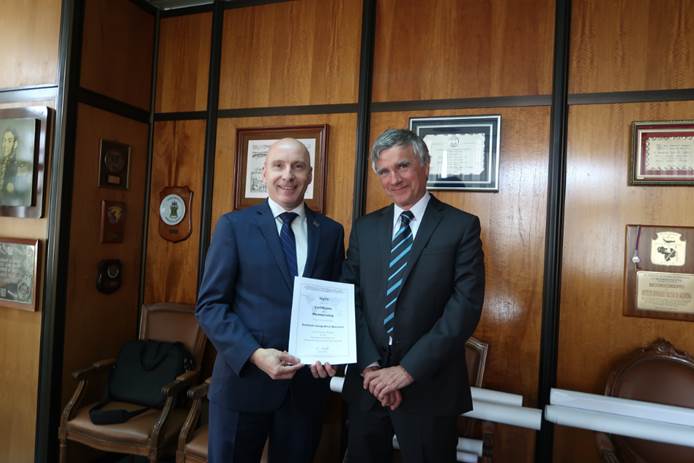
Sergio Rubén Cimbaro, President of IGN, receives the ISPRS membership certificate
from 2nd Vice President, Charles Toth
|
|
 |
|
WG III/5 Announcement for free Multi-Spectral and Mobile LiDAR Data

ISPRS Commission III on ‘Remote Sensing’ and WG III/5 on ‘Information Extraction from LiDAR Intensity Data’ are pleased to announce the availability of two data sets collected using different sensors and platforms. These trial data sets will be likely followed by others to be delivered in the future to support the academic and research community for experimental testing.
Data Set 1 was collected using the dual head sensor system Optech Lynx SG moving along a road in Sun Prairie (Wisconsin, US). A measurement rate (pulse repetition frequency) of 1200 kHz (600 kHz per sensor) and a scanner frequency of 250 Hz each sensor (total of 500 lines per second) has been used. The sample Data Set 1 consists of three strips collected using the two sensors (S1 and S2), stored in 6 LAS files for a total size of 4.5 GB.
Data Set 2 was collected using sensor Optech Titan, the world’s first multispectral airborne LiDAR sensor. Data Set 2 covers a natural coastal area located in Tobermory (Ontario, Canada). LiDAR data include three channels with wavelength 1550 nm, 1064 nm and 532 nm, respectively. Data Set 2 consists of 11 strips, stored in 33 LAS files for a total size of 26.4.
To receive any of the two data sets, please send an email to Dr. Marco Scaioni (marco.scaioni@polimi.it), Chair of WG III/5 or Dr. Ahmed Shaker (ahmed.shaker@ryerson.ca), Vice-President Commission III or Dr. Mattia Previtali (mattia.previtali@mail.polimi.it) who will be the persons in charge for handling data applications. Potential users will be asked to communicate their research plan and to send back some feedback on their results when available.
Acknowledgements go to ISPRS Sustaining Member Teledyne Optech (Dr. Ana Kersting and Dr. Paul La Rocque) for providing Data Sets 1 and 2, respectively. We also encourage other data providers to share new data sets for the ISPRS community.
|
|
 |
| |
 |
|
General Announcements
 |
|
Global Partnership using Space-based Technology Applications for Disaster Risk Reduction launched: GP-STAR

The purpose of GP-STAR is to facilitate the use of space-based technology applications, including Earth observation, global navigation satellite systems and satellite telecommunications, through a variety of efforts including the provision of technical advisory support for application in the context of the Sendai Framework for Disaster Risk Reduction 2015-2030 (Sendai Framework).
For more information visit:
http://www.un-spider.org/network/post2015_drr /
|
 |
|
IUGG Statement "The Earth’s climate and responsibilities of scientists and their governments
to promote sustainable development"

Following the announcement that the United States seeks to renegotiate, or withdraw from, the Paris Agreement on Climate Change, IUGG has released the Statement "The Earth’s climate and responsibilities of scientists and their governments to promote sustainable development".
Read the Statement here
|
 |
|
Advanced VR, iMmersive serious games and Augmented REality as tools to raise awareness and access to
European underwater CULTURal heritagE Newsletter

Background: The project iMARECulture is to raise public awareness of European identity by focusing in maritime cultural heritage, which by default bridges different civilizations. In particular, iMARECulture aims in bringing inherently unreachable underwater cultural heritage within digital reach of the wide public by implementing virtual visits, serious games with immersive technologies and underwater augmented reality. Scope of the project is to design, analyze, develop and validate pioneer applications and systems in the context of Virtual Museums through collaborative and innovative research from a diverse group of scientists, researchers, archaeologists, experts and museums.
Read the first newsletter here
See the brochure on iMARECulture here
|
 |
|
Call for Contributions to the special issue on Human Centered Virtual and Augmented Geovisualization Environments by the International Journal of Digital Earth (IJDE)

This special issue addresses user-centered visualization theories, concepts and applications that are related to VR/AR.
Contributions should report on unpublished research that advances the theory, design and technological implementation of new, cutting-edge human-centered augmented and virtual geovisualization environments.
For more information visit: http://explore.tandfonline.com/cfp/est/ijde/si-2
↑ Up
|
|
 |
| |
 |
|
Announcements of Scientific Meetings
(see also
ISPRS Calendar)
 |
|
UN/Austria Symposium on "Access to Space: Holistic Capacity-Building for the 21st Century"
Graz, Austria
September 3-7, 2017

This Symposium is the flagship event towards UNISPACE+50 Thematic Priority 7 (TP7). Under TP7, the office is starting a pilot project on a Space for Development Profile (SDP), to create a profile of the space domain of countries, and a Space Solutions Compendium (SSC), to provide solutions to improve the indicators defined in the SDP.
The Symposium will be an opportunity to open a dialogue on TP7 to discuss innovative approaches to capacity-building in the space domain, particularly in the areas of applications and technology, policy and law including the need to measure progress and development, identification of partners, tools for capacity-building and funding opportunities and aims at providing recommendations to COPUOS for UNISPACE+50 concerning this Thematic Priority.
For further information visit:
http://www.unoosa.org/oosa/en/ourwork/psa/schedule/2017/un-austria-symposium-access-to-space_-holistic-capacity-building-for-the-21st-century.html
For additional information please contact:
Jorge Del Rio Vera / Markus Woltram
U.N. Office for Outer Space Affairs (UNOOSA)
e-mail: jorge.delriovera@unoosa.org
e-mail: markus.woltram@unoosa.org
|
 |
|
8th Summer Student Seminar (3S)
Multi-Source Data Fusion Based Classification and Information Extraction
Novosibirsk, Russian Federation
September 4-8, 2017
Deadline for Summer Student Seminar application is 15 July

The 8th Summer Student Seminar with the participation of ISPRS Working Groups III/6 and V/2 is to be held at the Siberian State University of Geosystems and Technologies, 10, Plakhotnogo St., Novosibirsk, Russia.
This seminar consists of two intensive tracks:
- Multi-source data fusion based classification and information extraction (Dr. Anna Brook, University of Haifa),
- Virtual Reality (Dr. Pavel Kikin, and Dr. Aleksey Kolesnikov, Siberian State University of Geosystems and Technologies).
Contact: igor_musihin@mail.ru
For more information see the announcement
|
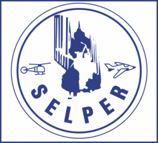 |
|
XI Workdays of Education in Remote Sensing in the Mercosur Area
20 years of education in remote sensing and spatial information systems
Temuco, Chile
November 13-17, 2017

SELPER Chapter Chile and the Catholic University of Temuco, with the support of ISPRS, organize and invite to the XI Conference on Education in Remote Sensing and Geotechnologies in the Mercosur area, held from November 13 to 17, 2017 in the city of Temuco-Chile.
A meeting to learn from remote sensing and space sciences, forming a common base that allows the development of students, teachers and professionals, through a continuous process of education that considers from the basic level to the postgraduate, in an integrative perspective that contributes to the sustainable development of our countries and the planet.
More information you will find here or contact:
Director
Carlos Esse H.
Email: cesse@uct.cl
Coordinator
Rodrigo Santander
Emails: rsantander@uct.cl, dir-eca@uct.cl
Claudia Herrera
Email: eca@uct.cl
Tel: +56 452 205432
Roberto Castro
Email: rcastro@selperchile.cl
|
 |
|
4th International Conference on Geographical Information Systems Theory, Applications and Management
GISTAM 2018
Funchal, Madeira / Portugal
March 17-19, 2018

The International Conference on Geographical Information Systems Theory, Applications and Management aims at creating a meeting point of researchers and practitioners that address new challenges in geo-spatial data sensing, observation, representation, processing, visualization, sharing and managing, in all aspects concerning both information communication and technologies (ICT) as well as management information systems and knowledge-based systems. The conference welcomes original papers of either practical or theoretical nature, presenting research or applications, of specialized or interdisciplinary nature, addressing any aspect of geographic information systems and technologies.
Submission Deadline: October 16, 2017
For more information visit: http://www.gistam.org/
e-mail: gistam.secretariat@insticc.org
↑ Up
|
|
 |
| |
 |
|
Event Reports
 |
|
Report on 37th ISRSE
Tshwane, South Africa
May 8-12, 2017
by John Trinder

The International Symposium on Remote Sensing of the Environment is the longest running conference on remote sensing, having commenced in 1962, although it has been rebadged over the period. The Symposium is managed by the space agencies around the world, on this occasion it was organised by the South African National Space Agency (SANSA) and held at the CSIR International Convention Centre in Tshwane (formerly Pretoria) South Africa.
Read the full report here….
|
 |
|
2 Report from the Workshop "Bridging space, time, and semantics in GIScience"
Wageningen, The Netherlands
May 9, 2017

The Workshop was one of the most successful AGILE Pre-Conference Workshops with interesting presentations and discussions and a large number of participants. It was co-organized by AGILE and ISPRS WG IV/1: IV/1 Multi-dimensional modelling and IV/2: Ontologies, Semantics, and Knowledge Representation for Geospatial Information.
Read the report here....
|
 |
|
Report on ISPRS International workshop "Photogrammetric techniques for video surveillance, biometrics and biomedicine – PSBB17"
Moscow, Russia
May 15-17, 2017
by Vladimir Knyaz, gosniias, Russia

The ISPRS International workshop «Photogrammetric techniques for video surveillance, biometrics and biomedicine - PSBB17» was held in Moscow, Russia from May 15th to May 17th 2017. It was the second in row ISPRS WG II/5 and WG II/10 International workshop in Moscow after PSBB15. The workshop was aimed for providing a platform for sharing the results of research and development efforts in both national and international video surveillance, biometrics, and biomedicine theory, research, experiments, applications, and technology. This time Lomonosov Moscow State University was a co-organizer and provided a venue of the workshop.
Read the full report
|
 |
|
Report on the ISPRS Hannover Workshop 2017
Hannover, Germany
June 6-9, 2017
by Franceso Nex, University of Twente, Enschede

This workshop has a very long tradition: the first meeting was organized in 1987 by Prof. Konecny under a different name, the current name was adopted in 2005. The workshop is traditionally organized and hosted by the Institute of Photogrammetry und Geoinformation (IPI) of the Leibniz Universität Hannover (Germany).
Read the report here…
|
 |
|
37th EARSeL Symposium
Prague, Czech Republic
June 27-30, 2017
by Lena Halounová, ISPRS Secretary General

In 2010, during the Centenary in Vienna, the European Association of Remote Sensing Laboratories (EARSeL) signed an MoU with ISPRS. EARSeL is an exceptional organisation founded in 1977 – 40 years ago. It is a society of laboratories of various organisations using remote sensing which organizes annual symposia in various European Cities. The last one took place in Prague at the Faculty of Civil Engineering of the Czech Technical University in Prague on 27 – 30 June 2017. The symposium brought new ideas and results in urban remote sensing, imaging spectroscopy, land use/land cover, thermal remote sensing, SAR, etc. An Abstract Book will be published at (
www.earsel.org,
http://earsel.org/publications/) soon. Papers from the Symposium will be publicized in EuJRS after the reviewing.

EARSeL founder and first President & present President
|
 |
|
Global Partnership using Space-based Technology Applications for disaster risk Reduction launched: GP-STAR at the Global Platform for Disaster Risk Reduction
Cancún Mexico

UN-SPIDER ("United Nations Platform for Disaster Management and Emergency Response - UN-SPIDER") is a United Nations programme established by the United Nations General Assembly
in its resolution 61/110 of 14 December 2006. ISPRS is a member of UN OOSA (UN Office for Outer Space Affairs). UN-SPIDER launched the GP STAR project in 2016.
The purpose of GP-STAR is to facilitate the use of space-based technology applications, including Earth observation, global navigation satellite systems and satellite telecommunications, through a variety of efforts including the provision of technical advisory support for application in the context of the Sendai Framework for Disaster Risk Reduction 2015-2030 (Sendai Framework).
First results of the project were presented at UNISDR Global Platform for Disaster Risk Reduction conference held in May in Cancún (
http://www.unisdr.org/conferences/2017/globalplatform/en). For the GP STAR project Brochure of the first phase of the project and more information visit:
http://www.un-spider.org/network/post2015_drr
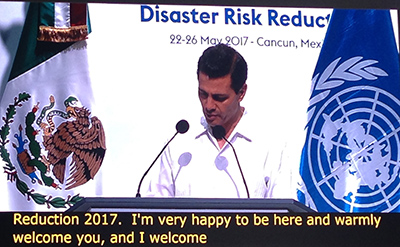
Mexican President welcoming UNISDR conference in Cancún
|
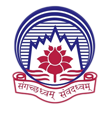 |
|
GeoHealth -2017
Hyderabad, India
July 1-2, 2017

GeoHealth -2017, a symposium on geospatial public health, was organized by the Inter-Commission Working Group on Environment and Health (ICWG III/IVc), in collaboration with the WG on Open Source on Geospatial Technology (WG V/8), and hosted by the Administrative Staff College of India (ASCI), and supported by ICORG. The symposium was preceded by a One day Workshop on Open Source Tools and Techniques in spatial health data analysis on June 30th, 2017. Plenary and technical sessions were conducted on July 1- 2, 2017. These sessions were participated by senior academic researchers and Indian federal government administrators/researchers. However, the active participation from younger field level researchers and also by a good number of clinicians made this symposium truly successful.
Participants agreed that while the current geospatial health research is very vibrant, further focus should be on generating useful environmental health information for clinical practice. The symposium was concluded with a consensus that in order to broaden the progress and to directly benefit human health, the geospatial health community must work with the healthcare providers and the outcomes need to be an essential part of the healthcare system.
Read more
↑ Up
|
|
 |
| |
 |
|
Obituaries
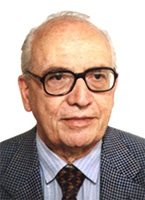 |
|
Mario Fondelli
1924 - 2017

Mario Fondelli (26 October 1924 – 17 February 2017) was an engineer and full professor at the University of Florence. He carried out considerable theoretical and experimental studies in photogrammetry and spatial aerial triangulation and gave courses at the University of Venice, Modena; he was a visiting professor at the Virginia Polytechnic Institute and State University in Blacksburg – Virginia (USA); at the Municipalidad de La Plata (Argentina), he was an honorary guest professor. Between 1988 and 1993, Mario was president of CIPA.
Read more
|
 |
|
Yuri S. Tjuflin
1934 - 2017

Yuri Tjuflin passed away on 10 May. He was a famous Russian photogrammetrist who made great contributions to Russian space and planet photogrammetry including his work on Venus surface modelling based on “Venera-15” and “Venera-16” satellite imagery. Yuri received the ISPRS Brock Gold Medal in 1996 and was the president of the RSPRS.
Read more
|
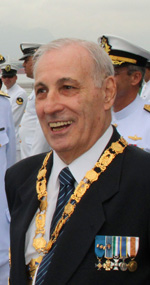 |
|
Paulo Cesar Teixeira Trino

On 13 May 2017, the Cartographic Community lost one of its most outstanding icons, with the passing of Cartography Specialist Engineer Paulo Cesar Teixeira Trino.
With his remarkable personality and immense obstinacy, he dedicated much of his professional life to the cause of Cartography.
His leadership has been effective since the beginning of his career, when he simultaneously assumed the presidency of three important institutions of the cartographic activity, the Brazilian Society of Cartography - SBC, the Brazilian National Association of Aerial Survey Companies - ANEA and the Brazilian Association of Cartographers - ABEC. He returned to the presidency of these institutions on several occasions, always with dedication and willingness equal to his first mandates. Until his death, he exercised cumulatively the presidencies of SBC and ANEA.
He has also held, for many years, as a representative of ANEA, the position of Board Member at the Brazilian National Cartography Commission - CONCAR.
A profound connoisseur of Universal History, where he improved his ability to formulate strategies, always in favour of Cartography, which, in addition to being aware of its historical details, has continually struggled for its development both in the Brazilian community and in the international community.
Paulo Cesar leaves our community in mourning, in which he made great and numerous friends and admirers.
|
 |
|
Wilfried Hartmann
1988 - 2017

We have the sad duty to inform the ISPRS community that Wilfried passed away on the 27th May, in a tragic accident during a hiking trip.
Wilfried studied geodesy and geoinformatics at Leibniz University Hannover, and received a BSc. degree in 2009. He then joint ETH Zurich, finished a MSc degree and became a PhD student and research assistant under the supervision of Konrad Schindler.
From 2012-2016 he was Secretary of ISPRS Technical Commission III "Photogrammetric Computer Vision". He was about to defend his dissertation this summer.
We feel deeply shocked about Wilfried's passing at such a young age. Our thoughts are with his family and friends.
|
|
 |
| |
 |
|
ISPRS International Journal of Geo-Information — Open Access Journal
 |
|
New publications in the ISPRS International Journal of Geo-Information
Open Access Journal
Volume 6, Issue 4 (April), No 92-125
A Lightweight CUDA-Based Parallel Map Reprojection Method for Raster Datasets of Continental to Global Extent
Li, Jing, Finn, Michael P., Blanco Castano, Marta
No: 92
A Novel k-Means Clustering Based Task Decomposition Method for Distributed Vector-Based CA Models
Li, Zhenqiang, Guan, Xuefeng, Wu, Huayi, Gong, Jianya
No: 93
A Procedural Construction Method for Interactive Map Symbols Used for Disasters and Emergency Response
Peng, Guoqiang, Yue, Songshan, Li, Yuting, Song, Zhiyao, Wen, Yongning
No: 95
Integration of GIS and Moving Objects in Surveillance Video
Xie, Yujia, Wang, Meizhen, Liu, Xuejun, Wu, Yiguang
No: 94
An Effective High-Performance Multiway Spatial Join Algorithm with Spark
Du, Zhenhong, Zhao, Xianwei, Ye, Xinyue, Zhou, Jingwei, Zhang, Feng, Liu, Renyi
No: 96
ASTROLABE: A Rigorous, Geodetic-Oriented Data Model for Trajectory Determination Systems
Navarro, José A., Parés, M. Eulàlia, Colomina, Ismael, Blázquez, Marta
No: 98
Affine-Invariant Triangulation of Spatio-Temporal Data with an Application to Image Retrieval
Haesevoets, Sofie, Kuijpers, Bart, Revesz, Peter Z.
No: 100
Spatial Data Sharing: A Pilot Study of French SDIs
Noucher, Matthieu, Gourmelon, Françoise, Gautreau, Pierre, Georis-Creuseveau, Jade, Maulpoix, Adeline, Pierson, Julie, Pinède, Nathalie, Pissoat, Olivier, Rouan, Mathias
No: 99
A Sparse Manifold Classification Method Based on a Multi-Dimensional Descriptive Primitive of Polarimetric SAR Image Time Series
He, Chu, Han, Gong, Feng, Di, Du, Juan, Liao, Mingsheng
No: 97
The Legibility and Permeability of Cities: Examining the Role of Spatial Data and Metrics
Silavi, Tolue, Hakimpour, Farshad, Claramunt, Christophe, Nourian, Farshad
No: 101
Validation of Spatial Prediction Models for Landslide Susceptibility Mapping by Considering Structural Similarity
Deng, Xiaolong, Li, Lihui, Tan, Yufang
No: 103
A Dynamic Indoor Field Model for Emergency Evacuation Simulation
Xiong, Qing, Zhu, Qing, Du, Zhiqiang, Zhu, Xinyan, Zhang, Yeting, Niu, Lei, Li, Yun, Zhou, Yan
No: 104
Integrating Geospatial Techniques for Urban Land Use Classification in the Developing Sub-Saharan African City of Lusaka, Zambia
Simwanda, Matamyo, Murayama, Yuji
No: 102
Ontology-Guided Image Interpretation for GEOBIA of High Spatial Resolution Remote Sense Imagery: A Coastal Area Case Study
Huang, Helingjie, Chen, Jianyu, Li, Zhu, Gong, Fang, Chen, Ninghua
No: 105
A Sparse Voxel Octree-Based Framework for Computing Solar Radiation Using 3D City Models
Liang, Jianming, Gong, Jianhua
No: 106
Spatial-Temporal Patterns of Bean Crop in Brazil over the Period 1990–2013
Clemente, Augusto Monso, Júnior, Osmar Abílio de Carvalho, Guimarães, Renato Fontes, McManus, Concepta, Turazi, Caroline Machado Vasconcelos, Hermuche, Potira Meirelles
No: 107
Towards Understanding Location Privacy Awareness on Geo-Social Networks
Abdelmoty, Alia I., Alrayes, Fatma
No: 109
Attribute Learning for SAR Image Classification
He, Chu, Liu, Xinlong, Kang, Chenyao, Chen, Dong, Liao, Mingsheng
No: 111
Camera Coverage Estimation Based on Multistage Grid Subdivision
Wang, Meizhen, Liu, Xuejun, Zhang, Yanan, Wang, Ziran
No: 110
Adaptive and Optimized RDF Query Interface for Distributed WFS Data
Zhao, Tian, Zhang, Chuanrong, Li, Weidong
No: 108
Uncertainties in Classification System Conversion and an Analysis of Inconsistencies in Global Land Cover Products
Zhang, Miao, Ma, Mingguo, De Maeyer, Philippe, Kurban, Alishir
No: 112
Interpolation and Prediction of Spatiotemporal Data Based on XML Integrated with Grey Dynamic Model
Bai, Luyi, Yan, Li, Ma, Zongmin
No: 113
A Spatio-Temporal Building Exposure Database and Information Life-Cycle Management Solution
Wieland, Marc, Pittore, Massimiliano
No: 114
Spatial Dynamic Modelling of Future Scenarios of Land Use Change in Vaud and Valais, Western Switzerland
Gago-Silva, Ana, Ray, Nicolas, Lehmann, Anthony
No: 115
A Standard Indoor Spatial Data Model—OGC IndoorGML and Implementation Approaches
Kang, Hae-Kyong, Li, Ki-Joune
No: 116
Marine Spatial Data Infrastructure Development Framework: Croatia Case Study
Tavra, Marina, Jajac, Niksa, Cetl, Vlado
No: 117
An Improved Density-Based Time Series Clustering Method Based on Image Resampling: A Case Study of Surface Deformation Pattern Analysis
Liu, Yaolin, Wang, Xiaomi, Liu, Qiliang, Chen, Yiyun, Liu, Leilei
No: 118
A GIS-Based Fuzzy Decision Making Model for Seismic Vulnerability Assessment in Areas with Incomplete Data
Sadrykia, Mansoureh, Delavar, Mahmoud Reza, Zare, Mehdi
No: 119
Identifying Witness Accounts from Social Media Using Imagery
Truelove, Marie, Khoshelham, Kourosh, McLean, Simon, Winter, Stephan, Vasardani, Maria
No: 120
Spatial and Temporal Analysis of the Mitigating Effects of Industrial Relocation on the Surface Urban Heat Island over China
Zhang, Linlin, Meng, Qingyan, Sun, Zhenhui, Sun, Yunxiao
No: 121
Building an Urban Spatial Structure from Urban Land Use Data: An Example Using Automated Recognition of the City Centre
Zhu, Jie, Sun, Yizhong
No: 122
Optimizing Multi-Way Spatial Joins of Web Feature Services
Lan, Guiwen, Zhang, Qiang, Yang, Zhao, Li, Tong
No: 123
Forecasting Urban Vacancy Dynamics in a Shrinking City: A Land Transformation Model
Lee, Jaekyung, Newman, Galen
No: 124
Generating Up-to-Date and Detailed Land Use and Land Cover Maps Using OpenStreetMap and GlobeLand30
Fonte, Cidália Costa, Minghini, Marco, Patriarca, Joaquim, Antoniou, Vyron, See, Linda, Skopeliti, Andriani
No: 125

Volume 6, Issue 5 (May 2017), No 126-154
Approach to Facilitating Geospatial Data and Metadata Publication Using a Standard Geoservice
Trilles, Sergio, Díaz, Laura, Huerta, Joaquín
No: 126
Reducing Building Conflicts in Map Generalization with an Improved PSO Algorithm
Huang, Hesheng, Guo, Qingsheng, Sun, Yageng, Liu, Yuangang
No: 127
Modeling the Hourly Distribution of Population at a High Spatiotemporal Resolution Using Subway Smart Card Data: A Case Study in the Central Area of Beijing
Ma, Yunjia, Xu, Wei, Zhao, Xiujuan, Li, Ying
No: 128
Detecting Damaged Building Regions Based on Semantic Scene Change from Multi-Temporal High-Resolution Remote Sensing Images
Tu, Jihui, Li, Deren, Feng, Wenqing, Han, Qinhu, Sui, Haigang
No: 131
Upscaling of Surface Soil Moisture Using a Deep Learning Model with VIIRS RDR
Zhang, Dongying, Zhang, Wen, Huang, Wei, Hong, Zhiming, Meng, Lingkui
No: 130
Semantic 3D Modeling Based on CityGML for Ancient Chinese-Style Architectural Roofs of Digital Heritage
Li, Lin, Tang, Lei, Zhu, Haihong, Zhang, Hang, Yang, Fan, Qin, Wenmin
No: 132
A G-Super4PCS Registration Method for Photogrammetric and TLS Data in Geology
Zhang, Rongchun, Li, Hao, Liu, Lanfa, Wu, Mingfei
No: 129
Uncovering Distribution Patterns of High Performance Taxis from Big Trace Data
Tang, Luliang, Sun, Fei, Kan, Zihan, Ren, Chang, Cheng, Luling
No: 134
Indoor Fingerprint Positioning Based on Wi-Fi: An Overview
Xia, Shixiong, Liu, Yi, Yuan, Guan, Zhu, Mingjun, Wang, Zhaohui
No: 135
Statistical Evaluation of No-Reference Image Quality Assessment Metrics for Remote Sensing Images
Li, Shuang, Yang, Zewei, Li, Hongsheng
No: 133
Ranking the City: The Role of Location-Based Social Media Check-Ins in Collective Human Mobility Prediction
Abbasi, Omid Reza, Alesheikh, Ali Asghar, Sharif, Mohammad
No: 136
Within Skyline Query Processing in Dynamic Road Networks
Huang, Yuan-Ko
No: 137
Novel Algorithm for Mining ENSO-Oriented Marine Spatial Association Patterns from Raster-Formatted Datasets
Cunjin, Xue, Xiaohan, Liao
No: 139
A Comparison of Terrain Indices toward Their Ability in Assisting Surface Water Mapping from Sentinel-1 Data
Huang, Chang, Nguyen, Ba Duy, Zhang, Shiqiang, Cao, Senmao, Wagner, Wolfgang
No: 140
Topographic Spatial Variation Analysis of Loess Shoulder Lines in the Loess Plateau of China Based on MF-DFA
Cao, Jianjun, Na, Jiaming, Li, Jilong, Tang, Guoan, Fang, Xuan, Xiong, Liyang
No: 141
Multi-Objective Emergency Material Vehicle Dispatching and Routing under Dynamic Constraints in an Earthquake Disaster Environment
Jiang, Jincheng, Li, Qingquan, Wu, Lixin, Tu, Wei
No: 142
Modeling Spatial Effect in Residential Burglary: A Case Study from ZG City, China
Chen, Jianguo, Liu, Lin, Zhou, Suhong, Xiao, Luzi, Song, Guangwen, Ren, Fang
No: 138
A Country Profile of the Czech Republic Based on an LADM for the Development of a 3D Cadastre
Janečka, Karel, Souček, Petr
No: 143
Monitoring and Assessing Post-Disaster Tourism Recovery Using Geotagged Social Media Data
Yan, Yingwei, Eckle, Melanie, Kuo, Chiao-Ling, Herfort, Benjamin, Fan, Hongchao, Zipf, Alexander
No: 144
Design of a Model Base Framework for Model Environment Construction in a Virtual Geographic Environment (VGE)
Zhang, Chunxiao, Ai, Gang, Zheng, Xinqi, Fang, Kun, Li, Jiayang
No: 145
Exploring the Relationship between the Arid Valley Boundary’s Displacement and Climate Change during 1999–2013 in the Upper Reaches of the Min River, China
Guo, Yalin, Wang, Qing, Fan, Min
No: 146
Impact of High-Resolution Topographic Mapping on Beach Morphological Analyses Based on Terrestrial LiDAR and Object-Oriented Beach Evolution
Meng, Xuelian, Zhang, Xukai, Silva, Rodolfo, Li, Chunyan, Wang, Lei
No: 147
Analysis of Burglary Hot Spots and Near-Repeat Victimization in a Large Chinese City
Wang, Zengli, Liu, Xuejun
No: 148
Investigation on the Expansion of Urban Construction Land Use Based on the CART-CA Model
Yao, Yongxiang, Li, Jia, Zhang, Xingguo, Duan, Ping, Li, Shuang, Xu, Quanli
No: 149
Change of Land Use/Cover in Tianjin City Based on the Markov and Cellular Automata Models
Wang, Ruci, Murayama, Yuji
No: 150
Spatio-Temporal Behavior Analysis and Pheromone-Based Fusion Model for Big Trace Data
Tang, Luliang, Zou, Qianqian, Zhang, Xia, Ren, Chang, Li, Qingquan
No: 151
Accuracy Assessment and Inter-Comparison of Eight Medium Resolution Forest Products on the Loess Plateau, China
Yang, Zhiqi, Dong, Jinwei, Liu, Jiyuan, Zhai, Jun, Kuang, Wenhui, Zhao, Guosong, Shen, Wei, Zhou, Yan, Qin, Yuanwei, Xiao,, Xiangming
No: 152
A Novel Analysis Method of Geographical Centrality Based on Space of Flows
Li, Jiwei, Qian, Jing, Liu, Yaolin
No: 153
The Standardization and Harmonization of Land Cover Classification Systems towards Harmonized Datasets: A Review
Yang, Hui, Li, Songnian, Chen, Jun, Zhang, Xiaolu, Xu, Shishuo
No: 154

Volume 6, Issue 6 (June 2017), No 155-184
Evaluation of Device-Independent Internet Spatial Location
Komosny, Dan, Pang, Paul, Mehic, Miralem, Voznak, Miroslav
No: 155
An Efficient Vector-Raster Overlay Algorithm for High-Accuracy and High-Efficiency Surface Area Calculations of Irregularly Shaped Land Use Patches
Xie, Peng, Liu, Yaolin, He, Qingsong, Zhao, Xiang, Yang, Jun
No: 156
Extraction of Terraces on the Loess Plateau from High-Resolution DEMs and Imagery Utilizing Object-Based Image Analysis
Zhao, Hanqing, Fang, Xuan, Ding, Hu, Josef, Strobl, Xiong, Liyang, Na, Jiaming, Tang, Guoan
No: 157
Registration of Multi-Level Property Rights in 3D in The Netherlands: Two Cases and Next Steps in Further Implementation
Stoter, Jantien, Ploeger, Hendrik, Roes, Ruben, Riet, Els van der, Biljecki, Filip, Ledoux, Hugo, Kok, Dirco, Kim, Sangmin
No: 158
A Method of Ship Detection under Complex Background
Nie, Ting, He, Bin, Bi, Guoling, Zhang, Yu, Wang, Wensheng
No: 159
A Map Spectrum-Based Spatiotemporal Clustering Method for GDP Variation Pattern Analysis Using Nighttime Light Images of the Wuhan Urban Agglomeration
Zhang, Penglin, Liu, Shuaijun, Du, Juan
No: 160
Integration of Landscape Metrics and Variograms to Characterize and Quantify the Spatial Heterogeneity Change of Vegetation Induced by the 2008 Wenchuan Earthquake
Wang, Ling, Tian, Bingwei, Koike, Katsuaki, Hong, Buting, Ren, Ping
No: 164
A Multiple Ant Colony Optimization Algorithm for Indoor Room Optimal Spatial Allocation
Yang, Lina, Sun, Xu, Zhu, Axing, Chi, Tianhe
No: 161
Management System for Dam-Break Hazard Mapping in a Complex Basin Environment
Mao, Jian, Wang, Shandong, Ni, Jianhua, Xi, Changbai, Wang, Jiechen
No: 162
Efficient Location Privacy-Preserving k-Anonymity Method Based on the Credible Chain
Wang, Hui, Huang, Haiping, Qin, Yuxiang, Wang, Yunqi, Wu, Min
No: 163
A Knowledge-Driven Geospatially Enabled Framework for Geological Big Data
Wu, Liang, Xue, Lei, Li, Chaoling, Lv, Xia, Chen, Zhanlong, Jiang, Baode, Guo, Mingqiang, Xie, Zhong
No: 166
Construction of a Decision Support System Based on GP Services, Using a Warning–Judgment Module as an Example
Sang, Xuejia, Xue, Linfu, Leng, Xiaopeng, Liu, Jiwen, Zhan, Liang
No: 167
A High Performance, Spatiotemporal Statistical Analysis System Based on a Spatiotemporal Cloud Platform
Jin, Baoxuan, Song, Weiwei, Zhao, Kang, Wei, Xiaoyan, Hu, Fei, Jiang, Yongyao
No: 165
Pan-Sharpening of Landsat-8 Images and Its Application in Calculating Vegetation Greenness and Canopy Water Contents
Rahaman, Khan Rubayet, Hassan, Quazi K., Ahmed, M. Razu
No: 168
Geospatial Analysis of Earthquake Damage Probability of Water Pipelines Due to Multi-Hazard Failure
Eskandari, Mohammad, Omidvar, Babak, Modiri, Mahdi, Nekooie, Mohammad Ali, Alesheikh, Ali Asghar
No: 169
A Conceptual Model for Delineating Land Management Units (LMUs) Using Geographical Object-Based Image Analysis
Gerçek, Deniz
No: 170
Application of a GIS-Based Slope Unit Method for Landslide Susceptibility Mapping along the Longzi River, Southeastern Tibetan Plateau, China
Wang, Fei, Xu, Peihua, Wang, Changming, Wang, Ning, Jiang, Nan
No: 172
LandXML Encoding of Mixed 2D and 3D Survey Plans with Multi-Level Topology
Thompson, Rodney James, van Oosterom, Peter, Soon, Kean Huat
No: 171
Morphing of Building Footprints Using a Turning Angle Function
Li, Jingzhong, Li, Xingong, Xie, Tian
No: 173
Geospatial Big Data-Based Geostatistical Zonation of Seismic Site Effects in Seoul Metropolitan Area
Kim, Han-Saem, Sun, Chang-Guk, Cho, Hyung-Ik
No: 174
Generalized Aggregation of Sparse Coded Multi-Spectra for Satellite Scene Classification
Han, Xian-Hua, Chen, Yen-wei
No: 175
Development and Comparison of Species Distribution Models for Forest Inventories
Rivera, Óscar Rodríguez de, López-Quílez, Antonio
No: 176
Adaptive Surface Modeling of Soil Properties in Complex Landforms
Liu, Wei, Zhang, Hai-Rong, Yan, Da-Peng, Wang, Sheng-Li
No: 178
Multi-Feature Joint Sparse Model for the Classification of Mangrove Remote Sensing Images
Luo, Yan-Min, Ouyang, Yi, Zhang, Ren-Cheng, Feng, Hsuan-Ming
No: 177
Retrieval and Comparison of Forest Leaf Area Index Based on Remote Sensing Data from AVNIR-2, Landsat-5 TM, MODIS, and PALSAR Sensors
Chen, Wei, Yin, Hang, Moriya, Kazuyuki, Sakai, Tetsuro, Cao, Chunxiang
No: 179
Experimental Evaluation of the Usability of Cartogram for Representation of GlobeLand30 Data
Han, Rui, Li, Zhilin, Ti, Peng, Xu, Zhu
No: 180
“Turn Left after the WC, and Use the Lift to Go to the 2nd Floor”—Generation of Landmark-Based Route Instructions for Indoor Navigation
Fellner, Irene, Huang, Haosheng, Gartner, Georg
No: 183
Towards a Planetary Spatial Data Infrastructure
Laura, Jason R., Hare, Trent M., Gaddis, Lisa R., Fergason, Robin L., Skinner, James A., Hagerty, Justin J., Archinal, Brent A.
No: 181
Quality Assessment Method for Linear Feature Simplification Based on Multi-Scale Spatial Uncertainty
Zhai, Jingsheng, Li, Zhaoxing, Wu, Fang, Xie, Hang, Zou, Bo
No: 184
↑ Up
|
|
 |
| |
 |
|
ISPRS Journal of Photogrammetry and Remote Sensing
 |
|
New publications in the ISPRS Journal of
Photogrammetry and Remote Sensing Volume 127 (May 2017)
Theme issue “Papers from Geospatial Week 2015”
Nicolas Paparoditis, Ian Dowma
Pages: 1-2
Rule-guided human classification of Volunteered Geographic Information
Ahmed Loai Ali, Zoe Falomir, Falko Schmid, Christian Freksa
Pages: 3-15
Development and evaluation of a specialized task taxonomy for spatial planning – A map literacy experiment with topographic maps
Victoria Rautenbach, Serena Coetzee, Arzu Çöltekin
Pages: 16-26
Cartographic continuum rendering based on color and texture interpolation to enhance photo-realism perception
Charlotte Hoarau, Sidonie Christophe
Pages: 27-38
A scalable and multi-purpose point cloud server (PCS) for easier and faster point cloud data management and processing
Rémi Cura, Julien Perret, Nicolas Paparoditis
Pages: 39-56
Comparing methods for the approximation of rainfall fields in environmental applications
G. Patané, A. Cerri, V. Skytt, S. Pittaluga, S. Biasotti, D. Sobrero, T. Dokken, M. Spagnuol
Pages: 57-72
Probabilistic multi-person localisation and tracking in image sequences
T. Klinger, F. Rottensteiner, C. Heipke
Pages: 73-88
Global robust image rotation from combined weighted averaging
Martin Reich, Michael Ying Yang, Christian Heipke
Pages: 89-101
Unmanned Aerial Systems and DSM matching for rock glacier monitoring
Elisa Dall’Asta, Gianfranco Forlani, Riccardo Roncella, Marina Santise, Fabrizio Diotri, Umberto Morra di Cella
Pages: 102-114
Lightweight UAV with on-board photogrammetry and single-frequency GPS positioning for metrology applications
M. Daakir, M. Pierrot-Deseilligny, P. Bosser, F. Pichard, C. Thom, Y. Rabot, O. Martin
Pages: 115-126

New publications in the ISPRS Journal of
Photogrammetry and Remote Sensing Volume 128 (June 2017)
Spatiotemporally enhancing time-series DMSP/OLS nighttime light imagery for assessing large-scale urban dynamics
Yanhua Xie, Qihao Weng
Pages: 1-15
Enhancement of low visibility aerial images using histogram truncation and an explicit Retinex representation for balancing contrast and color consistency
Changjiang Liu, Irene Cheng, Yi Zhang, Anup Basu
Pages: 16-26
A Poisson nonnegative matrix factorization method with parameter subspace clustering constraint for endmember extraction in hyperspectral imagery
Weiwei Sun, Jun Ma, Gang Yang, Bo Du, Liangpei Zhang
Pages: 27-39
Characterisation and improvement of the structure function estimation for application in PSI
Franz-Georg Ulmer, Nico Adam
Pages: 40-46
Mapping plastic greenhouse with medium spatial resolution satellite data: Development of a new spectral index
Dedi Yang, Jin Chen, Yuan Zhou, Xiang Chen, Xuehong Chen, Xin Cao
Pages: 47-60
Total canopy transmittance estimated from small-footprint, full-waveform airborne LiDAR
Milutin Milenković, Wolfgang Wagner, Raphael Quast, Markus Hollaus, Camillo Ressl, Norbert Pfeifer
Pages: 61-72
Species classification using Unmanned Aerial Vehicle (UAV)-acquired high spatial resolution imagery in a heterogeneous grassland
Bing Lu, Yuhong He
Pages: 73-85
Monitoring mangrove biomass change in Vietnam using SPOT images and an object-based approach combined with machine learning algorithms
Lien T.H. Pham, Lars Brabyn
Pages: 86-97
Remote sensing estimation of colored dissolved organic matter (CDOM) in optically shallow waters
Jiwei Li, Qian Yu, Yong Q. Tian, Brian L. Becker
Pages: 98-110
SigVox – A 3D feature matching algorithm for automatic street object recognition in mobile laser scanning point clouds
Jinhu Wang, Roderik Lindenbergh, Massimo Menenti
Pages: 111-129
An accelerated image matching technique for UAV orthoimage registration
Chung-Hsien Tsai, Yu-Ching Lin
Pages: 130-145
Hyperspectral remote sensing detection of petroleum hydrocarbons in mixtures with mineral substrates: Implications for onshore exploration and monitoring
Rebecca Del'Papa Moreira Scafutto, Carlos Roberto de Souza Filho, Wilson José de Oliveira
Pages: 146-157
Using spectrotemporal indices to improve the fruit-tree crop classification accuracy
M.A. Peña, R. Liao, A. Brenning
Pages: 158-169
An operational method for the disaggregation of land surface temperature to estimate actual evapotranspiration in the arid region of Chile
L. Olivera-Guerra, C. Mattar, O. Merlin, C. Durán-Alarcón, A. Santamaría-Artigas, R. Fuster
Pages: 170-181
Decomposition of LiDAR waveforms by B-spline-based modeling
Xiang Shen, Qing-Quan Li, Guofeng Wu, Jiasong Zhu
Pages: 182-191
Displacement monitoring and modelling of a high-speed railway bridge using C-band Sentinel-1 data
Qihuan Huang, Michele Crosetto, Oriol Monserrat, Bruno Crippa
Pages: 204-211
Remote identification of research and educational activities using spectral properties of nighttime light
Nataliya A. Rybnikova, Boris A. Portnov
Pages: 212-222
A Markov random field integrating spectral dissimilarity and class co-occurrence dependency for remote sensing image classification optimization
Leiguang Wang, Xin Huang, Chen Zheng, Yun Zhang
Pages: 223-239
Simultaneous inversion of multiple land surface parameters from MODIS optical–thermal observations
Han Ma, Shunlin Liang, Zhiqiang Xiao, Hanyu Shi
Pages: 240-254
C-Pro: A coastal projector monitoring system using terrestrial photogrammetry with a geometric horizon constraint
E. Sánchez-García, A. Balaguer-Beser, J.E. Pardo-Pascual
Pages: 255-273
Stitching images of dual-cameras onboard satellite
Yonghua Jiang, Kai Xu, Ruishan Zhao, Guo Zhang, Kan Cheng, Ping Zhou
Pages: 274-286
Self calibration of the stereo vision system of the Chang’e-3 lunar rover based on the bundle block adjustment
Shuo Zhang, Shaochuang Liu, Youqing Ma, Chen Qi, Hao Ma, Huan Yang
Pages: 287-297
Object-based analysis of multispectral airborne laser scanner data for land cover classification and map updating
Leena Matikainen, Kirsi Karila, Juha Hyyppä, Paula Litkey, Eetu Puttonen, Eero Ahokas
Pages: 298-313
Analysis and correction of ocean wave pattern induced systematic coordinate errors in airborne LiDAR bathymetry
Patrick Westfeld, Hans-Gerd Maas, Katja Richter, Robert Weiß
Pages: 314-325
Describing contrast across scales
Sohaib Ali Syed, Muhammad Zafar Iqbal, Muhammad Mohsin Riaz
Pages: 326-337
Effects of urban tree canopy loss on land surface temperature magnitude and timing
Arthur Elmes, John Rogan, Christopher Williams, Samuel Ratick, David Nowak, Deborah Martin
Pages: 338-353
Contextual segment-based classification of airborne laser scanner data
George Vosselman, Maximilian Coenen, Franz Rottensteiner
Pages: 354-371
Calibration of boresight offset of LROC NAC imagery for precision lunar topographic mapping
Bo Wu, Wai Chung Liu
Pages: 372-387

New publications in the ISPRS Journal of
Photogrammetry and Remote Sensing Volume 129 (July 2017)
Evaluating pixel and object based image classification techniques for mapping plant invasions from UAV derived aerial imagery: Harrisia pomanensis as a case study
Madodomzi Mafanya, Philemon Tsele, Joel Botai, Phetole Manyama, Barend Swart, Thabang Monate
Pages: 1-11
Automatic detection of Martian dark slope streaks by machine learning using HiRISE images
Yexin Wang, Kaichang Di, Xin Xin, Wenhui Wan
Pages: 12-20
Poor textural image tie point matching via graph theory
Xiuxiao Yuan, Shiyu Chen, Wei Yuan, Yang Cai
Pages: 21-31
Examining the strength of the newly-launched Sentinel 2 MSI sensor in detecting and discriminating subtle differences between C3 and C4 grass species
C. Shoko, O. Mutanga
Pages: 32-40
A morphologically preserved multi-resolution TIN surface modeling and visualization method for virtual globes
Xianwei Zheng, Hanjiang Xiong, Jianya Gong, Linwei Yue
Pages: 41-54
The Surface Extraction from TIN based Search-space Minimization (SETSM) algorithm
Myoung-Jong Noh, Ian M. Howat
Pages: 55-76
Assessing the performance of aerial image point cloud and spectral metrics in predicting boreal forest canopy cover
M. Melin, L. Korhonen, M. Kukkonen, P. Packalen
Pages: 77-85
Robust point cloud classification based on multi-level semantic relationships for urban scenes
Qing Zhu, Yuan Li, Han Hu, Bo Wu
Pages: 86-102
WREP: A wavelet-based technique for extracting the red edge position from reflectance spectra for estimating leaf and canopy chlorophyll contents of cereal crops
Dong Li, Tao Cheng, Kai Zhou, Hengbiao Zheng, Xia Yao, Yongchao Tian, Yan Zhu, Weixing Cao
Pages: 103-117
A voting-based statistical cylinder detection framework applied to fallen tree mapping in terrestrial laser scanning point clouds
Przemyslaw Polewski, Wei Yao, Marco Heurich, Peter Krzystek, Uwe Stilla
Pages: 118-130
Gold – A novel deconvolution algorithm with optimization for waveform LiDAR processing
Tan Zhou, Sorin C. Popescu, Keith Krause, Ryan D. Sheridan, Eric Putman
Pages: 131-150
Exploring diversity in ensemble classification: Applications in large area land cover mapping
Andrew Mellor, Samia Boukir
Pages: 151-161
Illumination compensation in ground based hyperspectral imaging
Alexander Wendel, James Underwood
Pages: 162-178
Feature matching evaluation for multimodal correspondence
M. Gesto-Diaz, F. Tombari, D. Gonzalez-Aguilera, L. Lopez-Fernandez, P. Rodriguez-Gonzalvez
Pages: 179-188
Mapping vegetation heights in China using slope correction ICESat data, SRTM, MODIS-derived and climate data
Huabing Huang, Caixia Liu, Xiaoyi Wang, Gregory S. Biging, Yanlei Chen, Jun Yang, Peng Gong
Pages: 189-199
A linearly approximated iterative Gaussian decomposition method for waveform LiDAR processing
Giorgos Mountrakis, Yuguang Li
Pages: 200-211
Feature learning and change feature classification based on deep learning for ternary change detection in SAR images
Maoguo Gong, Hailun Yang, Puzhao Zhang
Pages: 212-225
Fast ground filtering for TLS data via Scanline Density Analysis
Erzhuo Che, Michael J. Olsen
Pages: 226-240

↑ Up
|
|
 |
| |
 |
|
New Events
15-16 Jun 2017
First International Symposium of GRSS-Chile
A review of the State of the Art in Geoscience and the Remote Sensing in Chilean and the World
http://grss-chile.cl/
Valdivia, Chile
28-30 Jun 2017
UAS4Enviro 2017
Small Unmanned Aerial Systems for Environmental Research – 5th Edition
http://uas4enviro.org
Vila Real, Portugal
08-11 Jul 2017
Esri Imaging and Mapping Forum
http://www.esri.com/events/imaging-and-mapping
San Diego, CA , USA
12-18 Jul 2017
4th CIPA Summerschool
http://cipa.icomos.org/2017/04/01/4th_cipa_summer_school/
Pafos, Cyprus
16-17 Sep 2017
ISPRS Workshop on Collaborative and Dynamic Land Cover Information Services Supporting UN Sustainable Development Goals
http://ngcc.sbsm.gov.cn/article/en/ne/hl/201704/20170400008768.shtml
Jinan, China
22-23 Sep 2017
Geospatial Hackathon
http://www.geohack.hacettepe.edu.tr
Ankara, Turkey
09-10 Oct 2017
EuroSDR/ISPRS workshop Oblique 2017
http://www.eurosdr.net/workshops/eurosdrisprs-workshop-oblique-2017
Barcelona, Spain
16-19 Oct 2017
17th International Scientific and Technical Conference
“FROM IMAGERY TO DIGITAL REALITY: ERS & PHOTOGRAMMETRY”
http://conf.racurs.ru/conf2017/eng/
Hadera, Israel
28 Oct 2017
Workshop on Multi-Sensor Fusion for Dynamic Scene Understanding
in conjunction with ICCV 2017
https://msf-workshop.com/
Venice, Italy
01-03 Nov 2017
ILUS 2017
International Land Use Symposium 2017 - Use of spatial modelling and data visualisation to enlighten future sustainable policy making
http://www.ilus2017.ioer.info/
Dresden, Germany
06-09 Nov 2017
XXVII Brazilian Congress of Cartography
http://www.cartografia.org.br/cbc2017
Rio de Janeiro, Brazil
13-17 Nov 2017
XI JORNADA DE EDUCACION EN PERCEPCION
REMOTA EN EL AMBITO DEL MERCOSUR
website not yet available
Temuco, Chile
14-16 Nov 2017
Pecora20
20th William T. Pecora Memorial Remote Sensing Symposium
Observing A Changing Earth
http://pecora.asprs.org/
Sioux Falls, South Dakota , USA
24 Nov 2017
UDMV 2017
Urban Data Modelling and Visualisation
http://smartlivinglab.ch/index.php/en/home/events/189-udmv2017.html
Fribourg, Switzerland
27-30 Nov 2017
Pacific Islands GIS/RS User Conference 2017
Innovative GeoSpatial Solutions to Pacific Island Challenges
http://gisconference.gsd.spc.int/
Suva, Fiji Islands
15-17 Jan 2018
14th International Conference on Location Based Services
http://lbs18.ethz.ch/
Zurich, Switzerland
14-18 Mar 2018
Gi4DM
Geo-information for Disaster management
http://www.gi4dm2018.org
Kyrenia, Cyprus
17-19 Mar 2018
GISTAM 2018
4th International Conference on Geographical Information Systems Theory, Applications and Management
http://www.gistam.org/
Funchal, Madeira, Portugal
07-10 May 2018
ISPRS TC III Mid-term Symposium
on Developments, Technologies and Applications in Remote Sensing
http://www.isprs-tc3.tianditu.com/
Beijing, China
04-07 Jun 2018
ISPRS TC II Mid-term Symposium
website not yet available
Riva del Garda, Italy
03-06 Jul 2018
GI_Forum 2018
Symposium and Exhibit
http://www.gi-forum.org/
Salzburg, Austria
04 Jul 2018
AGIT 2018
Symposium and EXPO
http://www.agit.at
Salzburg, Austria
27 Aug - 02 Sep 2018
FOSS4G 2018
Academic Track
http://2018.foss4g.org/
Dares- Salaam, Tanzania
09-12 Oct 2018
ISPRS TC I Mid-term Symposium
website not yet available
Karlsruhe, Germany
15-19 Oct 2018
ISPRS TC IV Mid-term Symposium
website not yet available
Delft, The Netherlands
27-30 Nov 2018
ISPRS TC V Mid-term Symposium
website not yet available
New Delhi, India
» See more
|
 |
| |
 |
|
Updated Events
04 Dec 2017
ISPRS WG V/7 Workshop
“Geospatial Solutions for Structural Design, Construction and Maintenance in Training Civil Engineers and Architects”
and a seminar
“GIS-based Decision-making in Realizing Smart City Concept”
http://geospace.net.ua/isprs_eng.html
Kyiv, Ukraine
» See more
|
 |
| |
|
|
 |
You got this email as you subscribed to the ISPRS mailing list.
Officers, members and contact persons of members get it by default.
To unsubscribe from the ISPRS mailing list,
click here.
© ISPRS, 2017.
Imprint
|



